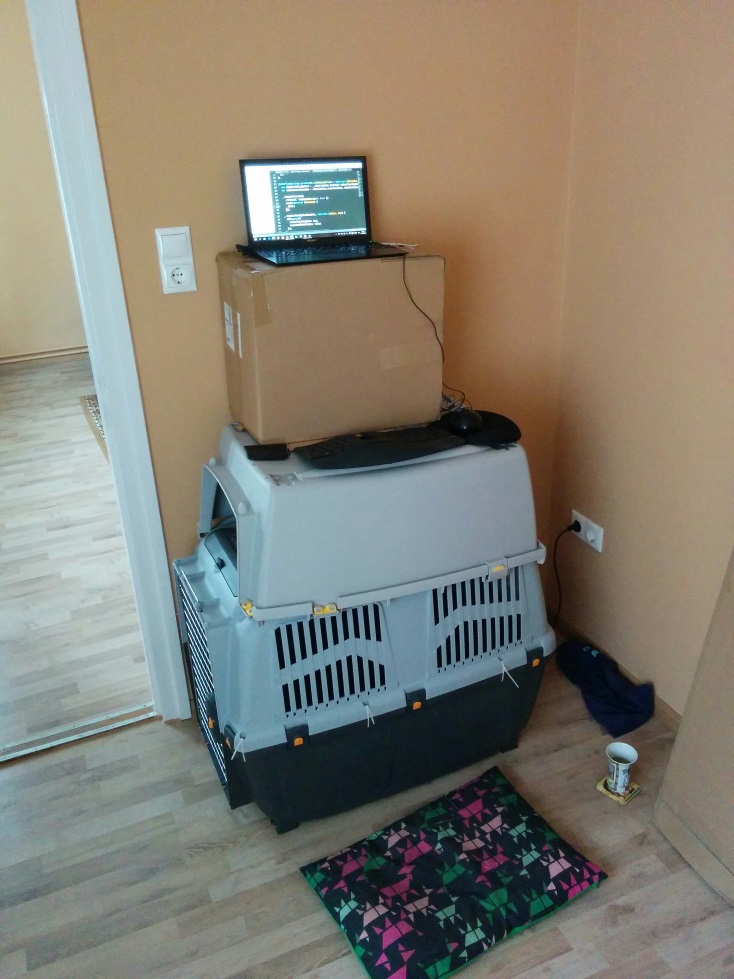Working remotely from abroad: One month in Hungary

I had been working remotely on several projects, but it was my first time working from abroad. My homeland is Finland and this time we went to Hungary for a month. In this blog post, I'll share experiences and tips on how to work efficiently while enjoying being in a different culture.
Getting there
I was traveling with my wife and our dog Fanni. We chose Saturday as a flight date so that I would be ready to work on Monday and there would be a little bit time to settle down. I assume that traveling with a dog is a bit similar than traveling with a child: you need to bring plenty of miscellaneous things.
From work perspective I had following equipment with me:
- Sony Vaio Pro (production discontinued)
- Microsoft Sculpt Ergonomic Desktop Keyboard and Mouse
- a mousepad with gel wrist support
The programming job doesn't require much equipment! Carbon fiber Vaio Pro weights only 1.06 kg (2.34 pounds). It's even more lightweight than Macbook Air (from early 2015) that weights 1.35 kg (2.96 pounds). Keyboard and mouse take some space but aren't that heavy. Some people can work long times with laptop's keyboard and touchpad, but I am not one of those. The external monitor would be a plus, but carrying 27" Dell wasn't worth it.
The tickets didn't have any discounts and total travel costs for all three of us were about 700€ (745.40 dollars as I am writing). That's a lot for the tickets, especially when the travel time is just two hours! The reasons for the high ticket price were a) quite late booking and b) "flexible" tickets and c) 150€ for a round-trip ticket for the dog. Point being: you can get the tickets way cheaper.
Work environment
When you're in your twenties, you can work in any posture and equipment, and you'll magically recover. As you get older you start to focus more on ergonomics and try to prevent repetitive strain injuries (RSA). Switching on a daily basis from sitting position to standing and vice versa doesn't prevent RSA, but it has other health benefits.
I had one room for work, so I built this beauty:

That's dog carriage box combined with a cardboard box. It's ugly as hell but surprisingly pleasant for the body. I used my dog's pillow as standing desk mat. It's quite squishy, but it's better than nothing.
2/3 of the day I was using standing desk and 1/3 sitting on a sofa. You have to get the laptop quite high so that the screen is at a right height. Average head weights about 4.5 to 5 kg (10 to 11 pounds) and if you have to look down while your spine is straight then you're using a quite bit of muscles to carry your head.
After having equipment, ergonomic setup and electricity there is still one key ingredient missing: The Internet.
The Internet
I went to the Telenor shop and asked for options. I was a bit surprised that I could only get prepaid mobile internet and not quotaless. The largest package was 30 gigabytes, so I went with that. That lasted about three weeks by avoiding streaming videos. The 4G connection was really fast and if allowed it would use the quota very fast! By the way, avoiding videos increases overall life quality as there are better things to do than watching funny dog/cat videos.
Additional 10 gigabytes was something like 10 euros. Sometimes I used internet cafes that decreased the usage a bit.
Takeaways:
- check the providers before-hand and walk straight into the right shop
- USB dongle provided mobile internet, but the SIM card option would be better as you could share the internet connection from the mobile to the laptop. I rarely called or received calls, so having a different number for a while would not have caused trouble.
Communication
There was an only one-hour time difference between me and rest of the team. I got up one hour earlier which meant that other teammates didn't have any problems with reaching me when needed.
The client was familiar with web-based communication before my trip, so nothing changed in that regards.
We had quite a standard set of modern tools:
- Slack for text-based communication / notifications
- Talky.io/Skype/join.me for video chat / screen sharing
- Trello to communicate status of the project
- GitHub for issue or code review related discussion
In a large corporation, communication tools might be predefined. Positive thing is that each team members has that tool already installed, but negative thing is that it might be good tool for a wrong task..
Takeaways:
- I enjoyed using Talky.io by &yet! You just open a modern browser (Safari) and send a link to the other participants. It worked smoothly from the mobile also, and it had much better video & sound quality than in Skype!
- train team members (especially non-technical ones) on using the communication tools before embarking
- have several choices for video chat. There are many variables between two persons: wireless connections, routers, different settings and software versions etc.
Difficulties
Number one problem is the communication. One-on-one discussions work nicely, but weekly meetings are not nearly as efficient or natural as they could. We were using laptop's camera, and if people are around a table, then the camera and microphone are facing only some of the participants. Now you probably think that of course they should have placed the camera so that everyone is seen and that there are plenty of good external cameras. And you're right. The problem is that regular web-camera has its limits when it comes to creating immersion.
The ideal situation would be that A) the remote worker would hear and see all participants and B) the rest of the team would feel that the person is there with them. I think with regular web-camera we're not experiences that just yet.
While you're there

I'll try to skip the regular holiday tips and focus on the work related things. Once you're in the country, why not go to local meetups or conferences. Or even talk in one.
I don't have any scientific proof on this, but I have noticed that if there is a foreign speaker in a meetup then people are more interested.
I thought people might be interested what a Finn has to say, so I asked organizers of Node.js Budapest that can I have a talk in their next event. I proposed a topic and got a green light from Mr. Oroszi Róbert!
On October 27th, I took a train from Sopron to Budapest and kept a talk. Met some great people and had interesting discussions. I'm not going to the details on this blog post, but you can read more about the talk and the event from this blog post.
Takeaways:
- keep few days off to participate on a conference or meetup
- giving a presentation in a different country is much easier than having a talk in your city! Most likely there aren't any friends watching
Conclusion
Even though it's not a beach holiday and work is still work regardless where you're, you can still experience much more than staying at home. Work healthy amount of hours and you'll still have the energy to explore the country and learn new things.
You should aim countries that have lower living cost than the country where you get your money. That might sound obvious, but it has some effect on the productivity as you don't have to do as many chores. For example, we cooked dinner only once as eating outside was so cheap (compared to Finland). The minimum amount of "extra stuff" and fewer distractions can improve your productivity and keep your boss/client happy. This will increase the chance of getting to work remotely again.
I hope this writing inspired you to at least think about working remotely from abroad! Let me know if you have tips, questions etc. I would be very happy to hear from you.
